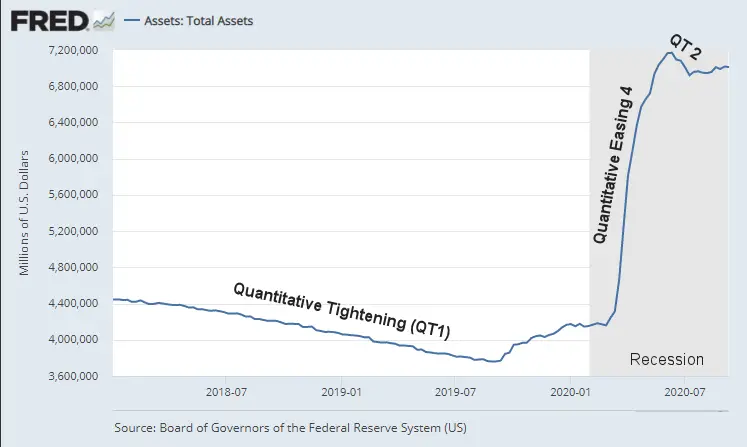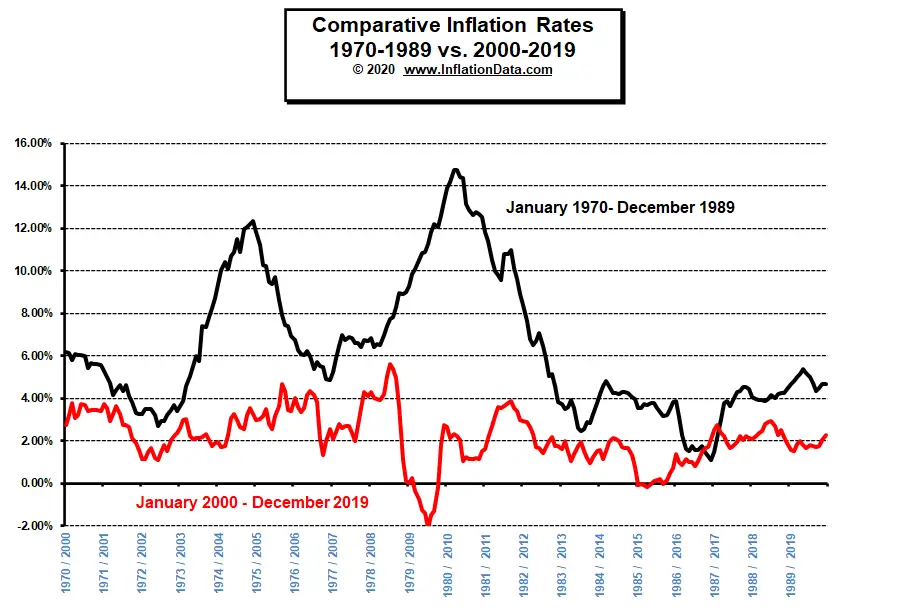COVID-19 has brought the global economy to its knees and in response, the governments of the world have opened the money printing spigots. The U.S. FED for instance has bought roughly 3 TRILLION in assets this year (labeled “Quantitative Easing 4” on this chart).
Many fear that this much “money printing” will result in massive inflation or even hyperinflation. As you can see from the chart below, high inflation rates were the bane of the 1970s and early 1980s when the inflation rate rarely dipped below 4%. By contrast, the period beginning with the new millennium has rarely seen inflation go above 4%. Inflation in the 1970s caused much suffering and business disruption, which means that if your company is to survive this period of financial instability, you must be prepared should inflation rear its ugly head once again.
Come to Grips with Inflation
With inflation having been low in recent memory, those with experience dealing with inflation may have retired so corporate experience in dealing with this sort of problem is limited. So it is essential that management must come to grips with the concept of inflation if you want to stand a serious chance of preparing your business for it. By enhancing your understanding of this unprecedented period of financial uncertainty, you will greatly improve your chances of being able to cope with it when it does start to have an impact on the day-to-day running of your organization.
For those of you that haven’t taken the time to study inflation, here’s a basic rundown on what it entails:
- Inflation is a period in which the overall prices of everyday goods and services start to rise.
- Corporate cost of materials and labor rise squeezing profits.
- Rising costs may or may not be able to be passed on to consumers depending on the price elasticity of demand (PED) of your products.
- When inflation causes costs to rise, often interest rates will spike (this reduces economic scalability on both an individual and a societal level).
- Rising interest rates can cause investors to chase interest-sensitive investments reducing cash flow or requiring companies to pay higher interest rates on borrowed capital.
- Inflationary pressures cause customers to try to delay payments in order to be able to pay with “cheaper dollars” so cash flow suffers.
Adjust Your Pricing Strategy
Once you’ve gotten to grips with inflation and fully understand the danger that it poses, you need to start preparing your organization for it. Adjusting your pricing strategy is the first step that you should consider taking in this instance. True, raising your prices can reduce demand so you must constantly be alert to the proper balance of price to volume. One way to fight an anticipated inflationary scenario is to lock in prices early. You can do this either through options/futures contracts or simply by signing long term contracts with suppliers. The key is to lock in prices for supplies while allowing you to raise prices on sales. In other words, you want to aim for fixed costs and rising income.
Improve Your Cash Flow and Reduce Your Operating Costs
Economic inflation will increase the financial pressure that your business is under; there’s no denying that. One of the most effective ways of reducing costs is to improve your cash flow. Don’t let your customers take advantage of your payment policies, institute penalties for late payment, and stay on top of accounts receivables.
If you’re serious about improving your cash flow, you also need to cut expenses not only for materials but labor as well. One way to do this is to invest in robust financial software. This includes not only invoicing but also payroll software as well. There are a whole host of tools out there that will help you improve your cash flow, recently Zenefits Payroll software has gotten good reviews and allowed companies to cut costs without laying off personnel.
Ways to cut your day-to-day operating costs are to:
- Hire Interns
- Hire Freelancers
- Conduct timely technology and services audits
- Relocate to a smaller, less expensive working environment
- Use Virtual Offices (Allow employees to work from home)
- Renegotiate with your suppliers
- Eliminate Finance Charges
- Review your professional indemnity insurance policy
- Ask Suppliers for Discounts
The financial waters are going to get choppy in the coming months; there’s no doubt about that. In your attempt to keep your business afloat, you need to face these challenges head-on.
The key to successfully negotiating an inflationary scenario is preparation, reducing costs, and being prepared to raise your own prices.
You might also like:
- How Does Inflation Affect Businesses?
- Why Inflation Affects Various Individuals Differently
- What Causes Inflation? Rising Prices Explained
- Will the $2 Trillion Covid-19 Stimulus Cause Inflation?
- Is the FED Tightening or Is Hyperinflation on the Horizon?
- Inflation: The Hidden Tax
- Modern Monetary Theory




Leave a Reply